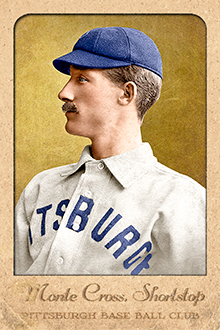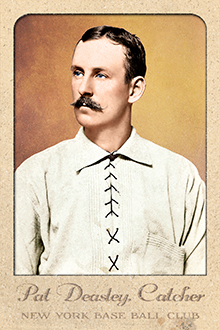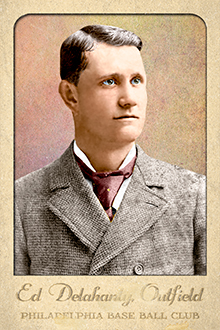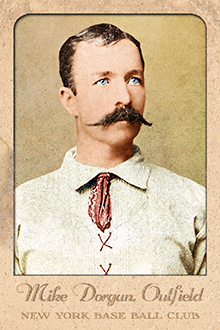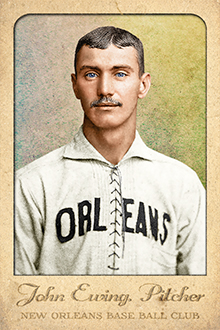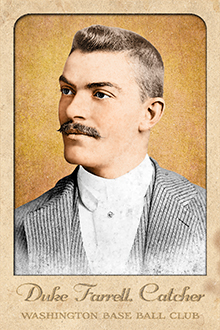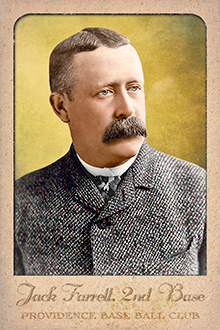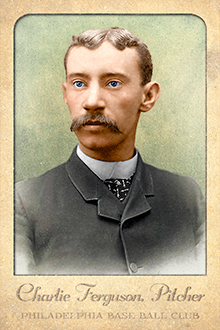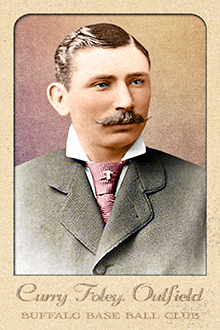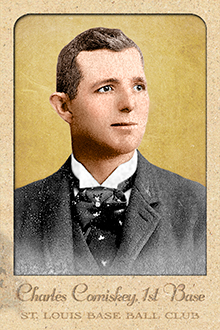
- Series: Pioneer Portraits II: 1875-1899
- City: St. Louis
- Team: Browns (AA)
- League: American Association
- Hall: National Baseball Hall of Fame
Charles Albert Comiskey (1859-1931) rose from decent first-baseman to become one of the foremost managers and owners of baseball’s early decades. “The Old Roman’s” leadership skills emerged with his first team, the newly-minted St. Louis Browns whom he piloted to four pennants. He would go on to compile an outstanding 840-541 record. His .608 winning percentage is third-highest behind Joe McCarthy and Jim Mutrie. “Commy” parlayed his ownership of the Western Association’s Dubuque Rabbits into a franchise in the American League which he helped found in 1901. He built the White Sox stadium in 1910 which would bear his name for the next 81 years and presided for the next decade over one of the most talented and troubled teams in history. While many dismiss the charge that it was Comiskey’s penurious ways that “drove” his 1919 squad to infamy, there is no doubt he was a cheapskate of the first order. He underpaid, over-promised and reneged with abandon, epitomizing the arrogance of the reserve-clause era.
- Charles is credited with revolutionizing play at first-base, innovating play off the bag
- Owned the Chicago White Sox from 1901-1931, winning two World Series
- Elected to Hall of Fame: 1939
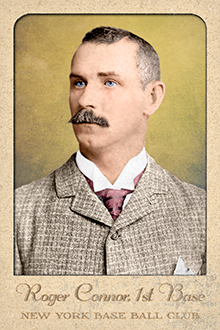
- Series: Pioneer Portraits II: 1875-1899
- City: New York
- Team: Giants
- League: National League
- Hall: National Baseball Hall of Fame
Roger Connor (1857-1931) was the home run king of the 19th century, clouting 138 in his 18-year career. His record stood for 23 years after his retirement, until Babe Ruth surpassed him in 1921. Connor anchored first-base for five teams, winning pennants twice with the Giants. His flair for the dramatic was never more evident than when he struck the first-ever major league grand slam with his team down by three with two outs in the ninth. Born in Connecticut, Roger played for local clubs until joining the Troy Trojans in 1880. That NY hamlet witnessed five future Hall of Famers on their squad with Connor playing alongside Dan Brouthers, Buck Ewing, Tim Keefe and Mickey Welch. After moving to the Gothams, the 6’3” Connor inspired owner Jim Mutrie to proclaim the team “my giants!” and a new identity was born.
- Much more than a slugger, Connor won the NL batting title in 1885 and consistently hit .300+ while exhibiting remarkable speed for a big man (still fifth all-time in triples)
- Connor lived to see Ruth claim his HR title. It was thought at the time, however, that Connor had hit 131 HRS and Ruth's record was celebrated at 132. Writing for SABR in 1975, John tattersall discovered that Connor had actually hit 138 HRs.
- Jay Jaffe's JAWS system ranks Connor as the 5th greatest 1st baseman of all-time, just behind Cap Anson and just ahead of Jeff Bagwell
- Beloved by fans and the baseball press, he had a particularly strong advocate for the Hall in fellow legend, umpire Bill Klem
- Elected to Hall of Fame: 1976
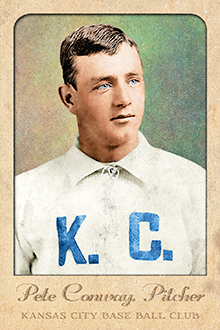
- Series: Pioneer Portraits II: 1875-1899
- City: Kansas City
- Team: Cowboys
- League: National League
Peter J. Conway (1866-1903) was a tough right-hander who played in tough luck with his early major-league clubs. Both the Buffalo Bisons and Kansas City Cowboys struggled to seventh-place finishes and failed to support their youngster during the 1885-86 seasons. He came into his own with a much better Detroit Wolverine squad for three years, helping the club win the pennant and post-season tourney in ‘87. Pete’s best year was in ‘88, going 30-14. The Wolverine franchise and Conway’s arm gave out. Pete went to the Alleghenys but got into only three games. Pressures were building that would culminate in the Players’ League “revolt” and the cavalier treatment Conway received in Pittsburgh was widely seen as all-too-typical. Pete tried unsuccessfully to play for Ward’s Wonders in 1890 but the arm was gone.
- In 1891 Conway was hired as the first head coach of the other Wolverines: those of the University of Michigan
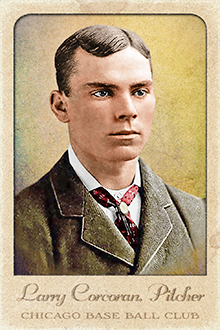
- Series: Pioneer Portraits II: 1875-1899
- City: Chicago
- Team: White Stockings
- League: National League
Lawrence J. Corcoran (1859-1891) was a shining star who left a short trail through the baseball heavens before flaming out in ill-health and an exhausted right arm. He could even use the left one and did pitch ambidextrously on at least one occasion. Few players of any era could have better fulfilled media prophecy: on Sept 13, 1879 the NY Clipper predicted that with good catching support “it would be difficult to get a base hit from his pitching.” Only two others would exceed Larry’s rookie 43 win total. By 1884 Corcoran would hurl his third no-hitter. He was the first to accomplish the feat and it wasn’t matched until Koufax many decades later. For five glorious years with Anson’s White Stockings, Corcoran was phenomenal: 170 wins, 246 CG and the no-nos.
- Unsurprisingly, the arm wearied. His body, afflicted by Bright’s disease, failed too, at age 32
- Per his SABR biographer: “Corcoran possessed all the attributes of greatness except durability”
- Series: Pioneer Portraits II: 1875-1899
- City: Pittsburgh
- Team: Pirates
- League: National League
Montford Montgomery Cross (1869-1934) enjoyed a 15 year career primarily in Philadelphia with the Phillies and, beginning in 1902, with the AL team, the Athletics. Cross consistently ranked first or near the top in several fielding categories such as shortstop assists and put-outs.
- Cross led the NL in strikeouts in 1901 and led the AL In the same category in 1906
- Upon his retirement in 1907, Cross was among the oldest major leaguers at 38
- Series: Pioneer Portraits II: 1875-1899
- City: Philadelphia
- Team: Quakers
- League: National League
Andrew J. “Tony” Cusick (1857-1929), was a journeyman catcher for the Philadelphia Quakers in the 1880s. His career batting average was less than stellar, falling below .200. Nevertheless, Cusick was popular with his teammates, particularly Jim Fogarty who gave him a hearty reference for the Milwaukee Brewers of the Western League after his final year in the majors.
- Went on to umpiring with similar results: His “incorrect calling of balls and strikes” was said by the Milwaukee Sentinel to have “brought down the anathemas of the vigorous-lunged ‘bleachers’ upon himself in consequence.”

- Series: Pioneer Portraits II: 1875-1899
- City: Chicago
- Team: White Stockings
- League: National League
Eliza G. Green Williams Brown Daggett (1851-1926) was hailed in her hometown in 1920 as “the woman who has made Attleboro famous.” As the first female in the Bay State to seek mayoral office, Eliza was, indeed, noteworthy. But it was her surreptitious labors for Al Spalding under her maiden name that earned her a place in the annals of baseball as well as politics.
Al Spalding's White Stockings (Cubs) had many a fractious player - “kickers” in the jargon of the day. Spalding needed someone to bring a sane, objective and expert eye to the task of recording for posterity the hits, errors and miscellanea of the club's performance; someone impervious to the importuning of players lobbying for favorable rulings from the scorekeeper. He found what he needed in a lady who lived across from the ballpark, a woman who was an avid fan and an inveterate record-keeper. Eliza scored every home game and she had the cool, detached manner of a secret agent. Spalding recruited her to be his anonymous official scorer and, for a decade (1882-91), Eliza sat with the players' wives, keeping meticulous score and passing judgement on hits and errors - even settling player arguments - but never betraying her professional role. The National League officials to whom Eliza dispatched her score cards never knew that “E.G. Green” was a woman, allowing Spalding to avoid the scandal that would have ensued had it been known that a woman held such an important job in the sports world of Nineteenth Century America.
- Eliza was able to avoid detection completely, even from club-omniscient captain Adrian Anson, despite the fact that Eliza usually performed her duties while sitting beside Anson's wife.
- Apparently, Eliza kept the secret even from her family. Her son Charles recounts that he would mail the scorecards to Major League Baseball for his mother, without ever knowing the contents or purpose of the packages.
- Daggett was a devoted suffragist, a friend of Susan B. Anthony, and a tireless campaigner for the Republican Party long before seeking office for herself
- Her son Charles Williams was team treasurer for the Cubs during their championship season of 1908
- Series: Pioneer Portraits II: 1875-1899
- City: Washington, D.C.
- Team: Nationals
- League: National League
Edward M. Daily (1862-1891) broke in with a bang for the Quakers in 1885, winning 26 games, 5th in the NL. He played mostly in the outfield for a few years and teams before returning to the mound in 1890 as the “star” pitcher for the Brooklyn Gladiators’ only year in the AA, going 10-15 for the last place club. With Ward’s Wonders of the Players’ League and the NL’s Bridegrooms, Daily was part of a three-team Brooklyn entry that one year.
- Got to play in the “world series” in 1890 for Louisville, Daily’s third team that frantic year
- Died following his stint with the Washington Statesmen in their final year in the AA
- Series: Pioneer Portraits II: 1875-1899
- City: Chicago
- Team: White Stockings
- League: National League
Abner Dalrymple (1857-1939) was one of the most prolific hitters of the fledgling NL. He was the leadoff batter for 8 straight years (with 5 pennants) for the Chicago White Stockings, contributing to a team home run record in 1884 that stood until eclipsed by the ’27 Bronx Bombers. He hit over .300 six times.
- Still shares a record for 4 doubles in 4 at-bats, July 3, 1883
- A.G. Spalding paid $2500 (!) to get Dalrymple from the Milwaukee Grays in 1878
- Dalrymple earned that confidence, winning the NL batting title in his rookie year
- In 1881 became first ever batter to be intentionally walked with bases loaded
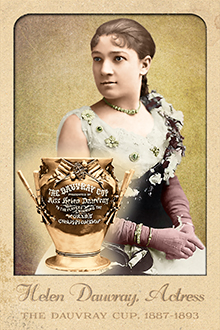
- Series: Pioneer Portraits II: 1875-1899
- League: National League
Ida Louisa Gibson (1856-1923), aka Helen Dauvray, was a child prodigy on the stage whose subsequent real estate investments made her wealthy. By 1887 her acting career was waning, but she had grown accustomed to and still longed for the acclaim accorded theatrical stars of her era. A love affair with celebrated baseball hero John Montgomery Ward was budding when Helen announced she would commission a "$500 . . . true lover's cup" to be presented annually to the players who triumphed in the “World's Championship” between the American Association and National League. In an era of shameless self-promotion, Helen's award gained traction in baseball and cast her back into the spotlight. It endured precisely as long as the romance between Monty Ward and the woman still known by many as Little Nell, the California Diamond after a long-running role of Helen's.
The Gorham Silver Co. finished the 12" tall cup on June 1, charging Helen $250. It was engraved “THE DAUVRAY CUP, Presented By Miss Helen Dauvray, to the players winning the WORLD'S CHAMPIONSHIP.” It didn't take long for some to realize that the cup would undoubtedly reside in the team owner's office, so Dauvray also commissioned medals to be given to individual players, a few of which survive in the Hall of Fame and private collections today.
Alas, the Dauvray Cup is now lost to history, having served its purpose from 1887-1893. The American Association expired following the 1890 tournament, so Miss Dauvray redirected it to become the trophy for the National League's champions. Helen had proposed that the cup become the permanent property of any club to win it three times consecutively, and the Boston Beaneaters took final possession following their third straight win in the fall of 1893. The cup was known to be in Kentucky that winter but, sadly, has disappeared since. Perhaps fittingly, the end of the cup's reign coincided with the Ward-Dauvray union's demise. Married in '87, the celebrity couple divorced in 1893.
The first recipients of the cup were not, as Dauvray may have expected, Ward's Giants. Rather, the Detroit Wolverines captured it first in a marathon 15-game series that was as much a barnstorming tour as a post-season tourney. The cup toured with the teams that inaugural year and offered Miss Dauvray the attention she sought, being displayed on the field during each game. In 1894, Helen's legacy lived on in the Temple Cup, instituted by Pirates owner William Chase Temple, to honor the winners of the NL's seven-game post-season series. It was awarded four times, last in 1897. Unlike its predecessor, the Temple Cup resides today in Cooperstown.
- Ars Longa is indebted to baseball historian John Thorn for his excellent research on the Dauvray Cup and the delightfully insouciant Miss Dauvray herself
- Series: Pioneer Portraits II: 1875-1899
- City: New York
- Team: Giants
- League: National League
Thomas H. Deasley (1857-1943) was a catcher for eight years for four ML clubs: the Boston Red Caps, St Louis Browns, NY Giants and Washington Statesmen from 1881 through ’88. This Irish immigrant compiled a .244 BA and did not hit a home run in the “Dead Ball” era.
- Pat’s best year was 1887 with the Giants, hitting .314 with a .367 OBP
- That NY team was noted for being nearly all Irish: Mike Dorgan, Pete Gillespie and Jim O’Rourke were the OF, while all but 2 innings in ’85 were pitched by Irishmen for example
- Series: Pioneer Portraits II: 1875-1899
- City: Philadelphia
- Team: Phillies
- League: National League
- Hall: National Baseball Hall of Fame
“Big Ed” Delahanty (1867-1903). Primarily an outfielder, Delahanty was one of the 19th century’s great power hitters. At .346, Big Ed has the 5th highest batting average of all-time. Ed once had 10 consecutive hits and twice had 6 hits in a game. One of five brothers to play pro baseball. Ed died in 1903, having been swept over Niagara Falls.
- Only player to win batting titles in both AL & NL
- 2nd player to hit 4 HRs in a game
- Elected to Hall of Fame: 1945
- Series: Pioneer Portraits II: 1875-1899
- City: Indianapolis
- Team: Hoosiers (NL)
- League: National League
Jeremiah Dennis Denny (1859-1927) was a rare ambidextrous third baseman who played professionally for over 20 years, 14 in the majors. He was the last position player to play his entire career without a glove. Denny led the ’84 Providence Grays to the first inter-league post-season tournament championship as the NL beat the AA in 1884.
- Holds the MLB record for chances by a third baseman in a game: 16 on 8/17/82
- Denny’s remarkable ability to throw with either hand led him to forego the glove
- Series: Pioneer Portraits II: 1875-1899
- City: New York
- Team: Giants
- League: National League
Michael Cornelius Dorgan (1853-1909) was an outstanding hitter and fielder whose career (and life) was cut short by numerous injuries due to his aggressive play. He starred for the St. Louis Brown Stockings and ended with the Syracuse Stars, his hometown team. Surgery on his knee, hurt making a game-saving catch in 1887, led to blood poisoning and his premature death.
- First Syracuse resident to play in the National League
- Awarded the New York Clipper Gold Badge Award as top defensive player at his position
- Managed parts of 3 seasons for 3 different NL teams from 1879-1881
- Elected to Syracuse Hall of Fame: 1999
- Series: Pioneer Portraits II: 1875-1899
- City: Cleveland
- Team: Blues (NL)
- League: National League
John Henry “Herm” Doscher, Sr. (1852-1934) was a no-nonsense player from 1872-82 and then umpired for three full seasons. He was not above using force to control unruly players. Herm was embroiled in a dispute with management over a contract that led to his temporary ouster from baseball before being exonerated in court and reinstated. He once recalled his days officiating games: “I’ve got to play ring master, school teacher, poppa, momma, and doctor in every game.”
- Doscher’s son Jack became the first second-generation major leaguer in 1903
- As a scout, Herm was credited with discovering Wee Willie Keeler
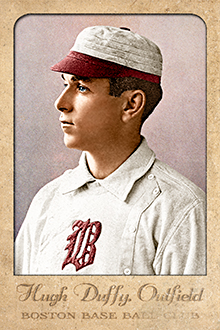
- Series: Pioneer Portraits II: 1875-1899
- City: Boston
- Team: Beaneaters
- League: National League
- Hall: National Baseball Hall of Fame
Hugh Duffy (1866-1954) is as much a baseball institution as the Hall of Fame that enshrines him. For 68 years he devoted himself to the game he loved and excelled at as few ever have. In 1894 he set the all-time mark with a .440 average while winning the triple crown. He made HOF pitchers look like batting practice coaches: .586 against John Clarkson, .650 vs Cy Young. Amos Rusie was the exception, holding Duffy to a mere .333. So diminutive Cap Anson nearly dismissed him (“We already have a bat boy”), Hugh hustled his way to becoming the only player to hit .300 in four leagues and let the power follow his form (“hit ‘em up the middle”) winning two HR titles. Duffy went on to coach, manage, scout and mentor for a half-century after hanging up his spikes. He was still hitting fungoes eight years after his induction into Cooperstown and delighted in pupil Ted Williams’ success as he sought in vain to eclipse Duffy’s record in 1941.
- Playing career spanned 19 years, primarily in Chicago, Boston and Philadelphia
- Played center field for the Beaneaters next to his “Heavenly Twin,” Tommy McCarthy in right, leading Boston to a pair of pennants
- Elected to Hall of Fame: 1945

- Series: Pioneer Portraits II: 1875-1899
- City: New York
- Team: Giants
- League: National League
Thomas John Esterbrook (1857-1901) played third and first base for seven different teams over 11 professional seasons. In 1884, Esterbrook had a terrific year, compiling a .314 batting average, with 150 hits, 29 doubles, 11 triples, 110 runs and an OPS+ of 150 for Jim Mutrie’s New York Metropolitans of the American Association. By 1889, Dude was player/manager of the Louisville Colonels during one of the most dismal seasons in MLB history (27-111, the worst record in the AA’s existence). As the losses mounted, tempers rose and Esterbrook’s attempts to fine players met with rebellion. He lost his post to “Chicken” Wolf who replaced him only to face the first true players’ strike when owner Mordecai Davidson reinstated Dude’s levies. Ironically, Esterbrook set his career mark, hitting .318 that woeful campaign, albeit in a part time role. His lifetime average in the majors was .261.
- Esterbrook’s confrontational style, evident in his short tenure as a manager, signalled emotional trouble ahead. His life ended at the age of 43 when he jumped from a train that was transporting him to a psychiatric hospital
- The Dude abides
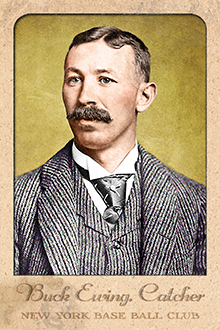
- Series: Pioneer Portraits II: 1875-1899
- City: New York
- Team: Giants
- League: National League
- Hall: National Baseball Hall of Fame
William Ewing (1859-1906) was the premier catcher of the 19th century, honored for decades after his early death as even, perhaps, the greatest player of all time. A scourge at bat, Buck hit over .300 ten times. He played behind the plate with courage and style, crouching close to the hitter so as to shave precious seconds off his inerrant throws. Ewing had debuted with the remarkable Troy Trojans in 1880 and joined four future Hall-of-Famers in moving to NYC in ‘83. The sturdy catcher may have been the primary inspiration for Jim Mutrie’s “my Giants!” exclamation that led to the new identity of the Gothams. An arm injury on a raw spring day curtailed his tenure behind the plate from 1891 on. Such a magnetic figure couldn’t escape the turmoil of the Players’ League controversies and Ewing was sometimes pilloried for lax effort. Despite such caviling, Ewing left as indelible a mark on the game’s first century as anyone. Upon his induction to Cooperstown (among the first six of the “pre-modern” era), he was hailed by Connie Mack as the greatest catcher he had seen and he had seen most.
- “Buck” was a derivative of “Buckingham,” bestowed on the budding star by an admiring scribe who wanted to add gravitas to the youngster’s reputation
- Played all nine positions and managed 3 different teams over 7 seasons
- Was the first catcher elected to the Hall of Fame; and the second 19th century player elected (after Cap Anson)
- Elected to Hall of Fame: 1939
- Series: Pioneer Portraits II: 1875-1899
- City: New Orleans
- Team: Pelicans
- League: Southern League
John Ewing (1863-1895) had three early cups of coffee, playing 1 game in 1883 for the St Louis Browns, 1 game in ‘84 for the “Outlaw Reds” of the Union Association, and 1 game also in ’84 for the Washington Nationals of the UA. In that game, Long John had a triple and scored– the full extent of his offense until returning to MLB four years later. Ewing finally caught on as a pitcher in 1888 with the Louisville Colonels, playing there for 2 seasons before ending his career with the 1890 Giants of the Players’ League and their NL club in ’91 where he went out with a bang, earning the NL’s ERA title with 2.27. In all, Ewing played for six ML teams in four leagues during his brief career.
- Ewing’s brother Buck went on to a Hall of Fame career as infielder/manager
- The brothers were teammates for two seasons and John played under Buck as manager in ‘90
- Series: Pioneer Portraits II: 1875-1899
- City: Washington, D.C.
- Team: Senators
- League: National League
Charles Andrew Farrell (1866-1925) was a much-beloved and highly touted catcher for 18 years. He played three years for Boston (AL), all pennant-winning clubs. Returning to Boston after a ten year absence, the Royal Rooters gave him a diamond ring on opening day. When the club played next in D.C., the Senators fans gave him “the greatest ovation a visiting player ever received on a Washington ball field.” And there was much to love: 1563 games, 1564 hits, 912 RBI. And Duke set a record that still stands, throwing out 8 of 9 attempted steals on May 11, 1897. Farrell earned praise at every stop in his nine-team career, with multiple stints with several of the clubs.
- Was reputed to have earned his nickname by consuming 380 clams
- After helping the Sox to the first world title in 1903, per Tim Murnane, Boston writer: “…Farrell is the greatest catcher the game has produced”
- Series: Pioneer Portraits II: 1875-1899
- City: Providence
- Team: Grays (NL)
- League: National League
John A. “Moose” Farrell (1857-1914) played 2nd base for 5 teams over 11 seasons. Served as player/mgr for the ’81 Providence Grays, achieving a 24-27 record before turning over the reins to Tom York. Always a reliable fielder, Farrell led or neared the lead in many defensive categories throughout his career.
- Averaged a modest .243 lifetime but hit .300+ twice (rookie season ’79 & ’83)
- Finished his career with the Orioles of the American Association in ’88 & ‘89
- Series: Pioneer Portraits II: 1875-1899
- City: Philadelphia
- Team: Quakers
- League: National League
Charles J. Ferguson (1863-1888) was considered by future Hall of Famer Wilbert Robinson to be the 5th best player of all-time when Ferguson succumbed to typhoid fever at age 25. Primarily a pitcher for the Quakers over four seasons, the right-hander also handled the outfield and second-base. He won at least 21 games each year and was lights-out in 1886, winning 30 with a 1.98 ERA (2nd in the league). Playing more outfield the next year, Ferguson not only won 22 but drove in 85 with a .327 average. The youngster was stricken before the ’88 season and never recovered.
- Hurled a no-hitter against the Providence Grays on Aug 29, 1885
- In tribute to this young warrior, the Quakers and three other NL teams wore black crepe for the entire 1888 season
- Decades later, W.B. Hanna dubbed him “the game’s best all around player”
- Robinson ranked Ferguson 5th all time after Cobb, Keeler, Ruth and Wagner
- Series: Pioneer Portraits II: 1875-1899
- City: Philadelphia
- Team: Quakers
- League: National League
James G. Fogarty, (1864-1891) was a speedy outfielder and infielder with the Philadelphia Quakers of the NL and the Philadelphia Athletics of the Players’ League where he was also the manager. Fogarty was one of the swiftest of the early era, stealing a league high 99 bases in 1889. In his seven years in Philly, Fogarty was a consistent offensive contributor, driving in 35 to 58 runs each season.
- A native San Franciscan, Fogarty graduated from St Mary’s College of California
- Joined the short-lived Players’ League, 1890 in an attempt to break the reserve clause
- Died way too early of tuberculosis in Philadelphia at age 27
- Series: Pioneer Portraits II: 1875-1899
- City: Buffalo
- Team: Bisons
- League: National League
Charles Joseph Foley (1856-1898) was a versatile Irishman with the Boston Redcaps & Buffalo Bisons over six seasons, playing OF, 1B & pitching. Foley was an early & tragic victim of the reserve clause. Already impaired by rheumatism, he was run out of the game by management who saw a faker & would neither play nor release him.
- First batter to hit for the cycle (in 1882)
- Participated in the first duel of left-handers, versus Bobby Mitchell of Cleveland, July 19, 1879
- Cited by John Montgomery Ward as a prime example of the abuses of the reserve clause
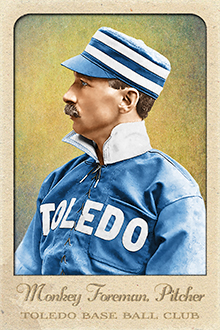
- Series: Pioneer Portraits II: 1875-1899
- City: Toledo
- Team: White Stockings
- League: Western League
Francis Isaiah Foreman (1863-1957) played hardball for 28 pro franchises over a career that began with the Lancaster, PA Ironsides in 1884 and ended with the Meriden, CT Silverites in 1905. Such longevity suggests the big guy (over six feet) knew how to pitch and how to protect his arm in an era when so many burned out quickly. Fifty-four of his 96 career wins in the majors came in a three year streak with Baltimore, Cincinnati and Washington from 1889-91. Foreman could hit, too, at least when the fences came in. On July 4, 1895 Frank pitched the nightcap for his Reds in Chicago. The local officials wanted to accommodate the expected crowd and moved the fences in a hundred feet. Umps ruled balls in seats would be HRs. Frank hit two, but surrendered six, losing 9-5.
- Frank’s brother Brownie joined him with the Reds in ‘96 putting the Foremans on a list of nearly 100 brother-teammates in big league history
- Frank coached at Gettysburg College in the off-season and showed his eye for talent when he urged his friend Connie Mack to sign a kid named Eddie Plank in 1901




